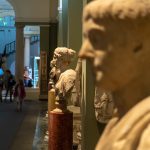When it comes to pursuing higher education in Italy, the University of Rome La Sapienza is a name that resonates with excellence, prestige, and history. Founded in 1303, La Sapienza is one of the oldest and largest universities in Europe, with over 100,000 students enrolled in its various undergraduate and graduate programs. With its strong focus on research, innovation, and academic excellence, the University of Rome La Sapienza has established itself as a leading institution of higher learning in Italy and around the world. In this article, we will delve into the history, academic programs, campus facilities, and student life of this venerable institution, providing you with a comprehensive guide to one of the most prestigious universities in Europe.
Content Quick Navigation
University of Rome La Sapienza Medical school
The University of Rome La Sapienza has a long-standing reputation for excellence in medicine and health sciences, making it one of the most sought-after destinations for medical education in Italy and beyond. With its strong focus on research and innovation, La Sapienza has a comprehensive range of medical programs and facilities, attracting some of the brightest minds in the field. One of the university’s strengths is its state-of-the-art medical campus, which features cutting-edge equipment and facilities, including laboratories, clinics, and hospitals. This provides medical students with hands-on training and practical experience, ensuring that they are well-equipped to deal with the challenges of the medical profession. Furthermore, the university boasts a highly qualified faculty, composed of respected scholars and medical professionals with extensive experience in their respective fields. With a student-to-faculty ratio of 12:1, students have the opportunity to work closely with their professors, receiving personalised attention and guidance throughout their academic journey. The university also offers a wide range of medical programs, including undergraduate and graduate degrees, as well as specialisation programs and research opportunities. These programs are designed to provide students with a well-rounded education, combining theoretical knowledge with practical experience, and preparing them for successful careers in medicine. Overall, the University of Rome La Sapienza is an outstanding choice for those looking to pursue a career in medicine. With its world-class facilities, expert faculty, and comprehensive range of programs, La Sapienza provides students with an unparalleled education and a strong foundation for success in the field of medicine.
IMAT Minimum Scores
| Year | Minimum Score (Non-European) | European Scores (First/Last Round) |
|---|---|---|
| 2020 | 42.3 | First: 53.7 / Last: 46.7 |
| 2021 | 53.1 | First: 47.6 / Last: 40.4 |
| 2022 | 52.6 | First: 48.2 / Last: 42.8 |
| 2023 | 50.8 | First: 46.7 / Last: 45.4 |
History and Background
La Sapienza University of Rome:
The University of Rome was established in 1303 by Pope Boniface VIII and included the teaching of medicine as part of its curriculum. Over the centuries, the university underwent many changes and reforms, with popes playing a significant role in the development of the medical program. Under Pope Paul III, anatomy became a discipline in itself, and under Pope Julius III, only the Medical College was allowed to award degrees in medicine. Later, Pope Clement X introduced a compulsory hospital internship for graduates to obtain their degree or practice their profession. Benedict XIV reorganized university studies, and by 1810, the university had undergone changes to the regulations governing university studies according to the Napoleonic laws for medical faculties. Practical clinical medical training was officially introduced in 1815, and in 1824, a university medical reform was implemented. After the Unification of Italy in 1870, the university underwent further changes, and the Faculties of Medicine and Surgery were merged into a single faculty with a six-year degree course.
Weather
The climate in Rome, where the University of Rome La Sapienza is located, is generally Mediterranean, characterised by hot, dry summers and mild, wet winters. The city experiences four distinct seasons, with temperatures typically ranging from around 15 degrees Celsius in the winter to 30 degrees Celsius or more in the summer. During the summer months, the weather in Rome can be quite hot and humid, with temperatures sometimes exceeding 35 degrees Celsius. This can make outdoor activities and walking around the city uncomfortable, especially during the middle of the day. However, the city’s numerous fountains and shaded squares provide respite from the heat, and many locals and visitors alike take advantage of the cool breezes that come in off the nearby sea. In the winter, Rome can be quite rainy and chilly, with temperatures occasionally dropping below freezing. However, snow is rare in the city itself, and most precipitation comes in the form of rain. Overall, the climate in Rome is generally mild and pleasant, with plenty of sunshine and mild temperatures for much of the year. While the summer months can be hot and humid, the city’s many attractions, cultural events, and opportunities for outdoor recreation make it a popular destination for visitors and students alike.
Curriculum and Timetable
| Year | Course | Time Table | Description |
| Year 1 | Anatomy and Histology | September – January | This course provides an introduction to the structure and function of the human body, including an overview of the major organ systems and their interrelationships. |
| Biochemistry | February – June | This course covers the chemical processes that occur within living organisms, including metabolism, energy production, and protein synthesis. | |
| Year 2 | Physiology | September – January | This course focuses on the functions of the various organ systems in the body and how they work together to maintain homeostasis. |
| Pharmacology | February – June | This course covers the study of drugs and their effects on the body, including mechanisms of action, pharmacokinetics, and pharmacodynamics. | |
| Year 3 | Pathology | September – January | This course covers the study of disease processes, including the causes, mechanisms, and consequences of various diseases. |
| Microbiology | February – June | This course covers the study of microorganisms, including bacteria, viruses, and fungi, and their interactions with the human body. | |
| Year 4 | Internal Medicine | September – January | This course provides an overview of the diagnosis, treatment, and management of diseases affecting the internal organs and systems of the body. |
| Surgery | February – June | This course covers the principles and techniques of surgical procedures, including preoperative evaluation, anaesthesia, and postoperative care. | |
| Year 5 | Pediatrics | September – January | This course covers the diagnosis, treatment, and management of diseases and conditions affecting children, from infancy to adolescence. |
| Obstetrics and Gynecology | February – June | This course covers the study of the female reproductive system, including pregnancy, childbirth, and women’s health issues. | |
| Year 6 | Electives | September – January | Students can choose from a variety of elective courses in areas such as cardiology, neurology, oncology, and more. |
| Clinical rotations | February – June | Students will complete clinical rotations in various specialties, including internal medicine, surgery, paediatrics, and obstetrics and gynaecology. |
The time table for each year varies slightly, but generally runs from September to June, with breaks for holidays and exams. In addition to classroom lectures and laboratory work, students will also complete clinical rotations and gain hands-on experience working with patients in various settings, including hospitals and clinics.
Overall, the curriculum at the University of Rome La Sapienza Medical School is designed to provide students with a solid foundation in the basic sciences, while also emphasising the practical skills and knowledge necessary for success as a medical practitioner. With a focus on hands-on learning and clinical experience, students can expect to graduate with the skills and confidence needed to succeed in a variety of medical fields.
Tuition Fees and Costs
| Expense | Cost (Euro) |
| Tuition fee | 156€-3500€ per year |
| Accommodation | 300€-600€ per month |
| Food | 200€-300€ per month |
| Transport | 35€-70€ per month |
| Books and supplies | 50€-100€ per month |
| Health insurance | 35€-50€ per month |
| Leisure and personal | 150€-250€ per month |
| Total Monthly Cost (approximately) | 770€-1,920€ per month |
It is important to note that tuition fees may vary depending on the ISEE (Equivalent Financial Situation Indicator) option. The ISEE is an indicator of the economic situation of a student’s family, and based on this, students can apply for a reduction in tuition fees. The maximum amount of reduction is up to 100% of the tuition fee. Additionally, there are government scholarships available for students based on their financial need and academic performance. These scholarships can help cover the cost of tuition fees, accommodation, and other living expenses. It is always a good idea to research and plan your budget carefully when considering studying abroad, and to take advantage of any financial assistance that may be available to you.
Research and Innovation
Research and innovation are at the heart of the University of Rome La Sapienza, and are integral to its mission of academic excellence and social progress. The university has a long-standing tradition of producing groundbreaking research in a wide range of fields, from medicine and science to humanities and social sciences. One of the key factors that sets La Sapienza apart is its strong emphasis on interdisciplinary research, which allows scholars from different disciplines to collaborate and share ideas. This approach has led to a number of important breakthroughs in areas such as medicine, environmental science, and engineering, and has helped to position La Sapienza as a leader in innovation and research. The university is home to a number of research centres and institutes, each dedicated to advancing knowledge in specific areas. These include the Institute of Molecular Biology and Pathology, the Institute of Atmospheric Sciences and Climate, and the Institute of Archaeology. These centres provide researchers with access to state-of-the-art facilities and equipment, as well as opportunities to collaborate with colleagues from around the world. In addition to its research centres, La Sapienza has a strong track record of attracting funding from both public and private sources, enabling its scholars to undertake ambitious and cutting-edge research projects. This has led to numerous publications in top-tier academic journals, as well as the development of new technologies and innovations with real-world applications. Overall, the University of Rome La Sapienza is a hub of innovation and research, with a strong commitment to advancing knowledge and promoting social progress. Its interdisciplinary approach, state-of-the-art facilities, and talented faculty and students make it a driving force in shaping the future of research and innovation in Italy and beyond.
Campus Facilities
The University of Rome La Sapienza boasts a beautiful and historic campus located in the heart of Rome. The campus is spread across several different locations throughout the city, with its main campus situated in the historic district of San Lorenzo. The campus is home to a wide range of academic and administrative buildings, as well as state-of-the-art research facilities and laboratories. These facilities provide students and faculty with access to cutting-edge technology and equipment, and create a dynamic and stimulating environment for learning and research. In addition to its academic facilities, La Sapienza offers a wide range of resources and services to support student life. These include modern and well-equipped libraries, sports facilities, and cultural activities. The university also provides a variety of student services, including career counselling, academic advising, and health services. The campus itself is a vibrant and bustling hub of activity, with students from around the world coming together to learn, explore, and socialise. The university has a strong tradition of student activism and engagement, and offers a wide range of student organisations and clubs for students to get involved in. Overall, the campus and facilities of the University of Rome La Sapienza are world-class, providing students and faculty with the resources and environment they need to excel in their academic and research pursuits. The university’s commitment to innovation, interdisciplinary collaboration, and academic excellence is reflected in its state-of-the-art facilities and vibrant campus life, making it a truly unique and exciting place to study and work.
Student Life
Student life at the University of Rome La Sapienza is vibrant, dynamic, and engaging. The university attracts students from all over Italy and the world, creating a diverse and multicultural community of learners. La Sapienza has a strong tradition of student activism and engagement, with a wide range of student organisations and clubs available for students to get involved in. These groups cover a wide range of interests, from sports and recreation to politics and social justice. The university also hosts a number of cultural events throughout the year, including concerts, exhibitions, and lectures, providing students with opportunities to broaden their horizons and explore new interests. The city of Rome itself offers an endless array of cultural and historical attractions, from world-famous museums and galleries to iconic landmarks such as the Colosseum and the Vatican. In addition to its cultural and social offerings, La Sapienza provides a variety of resources and services to support student success. These include academic advising and tutoring, career counselling, and health services. The university also has a strong focus on research and innovation, providing students with opportunities to work alongside faculty on cutting-edge research projects and gain valuable hands-on experience. Overall, student life at the University of Rome La Sapienza is rich, varied, and rewarding, offering students a wide range of opportunities for personal and academic growth. Whether pursuing a degree in medicine, engineering, humanities, or social sciences, students at La Sapienza are sure to find a supportive and stimulating environment in which to learn and thrive.
Conclusion
In conclusion, the University of Rome La Sapienza Medical School is a prestigious institution with a long history of excellence in medical education and research. With a diverse and innovative curriculum, state-of-the-art facilities, and a vibrant student community, the university provides an exceptional learning experience for students from all over the world. Students can expect to experience a wide range of academic and extracurricular activities that will enrich their knowledge and prepare them for a successful career in the medical field. In addition, the university offers various financial assistance options, including the ISEE reduction in tuition fees and government scholarships, to help make studying abroad more accessible to all students. Overall, the University of Rome La Sapienza Medical School is an excellent choice for anyone seeking a high-quality medical education in Europe. With its world-class reputation, outstanding faculty, and exceptional facilities, it is a top destination for students looking to pursue their dreams in the field of medicine. Don’t hesitate to contact us by joining our communities!













